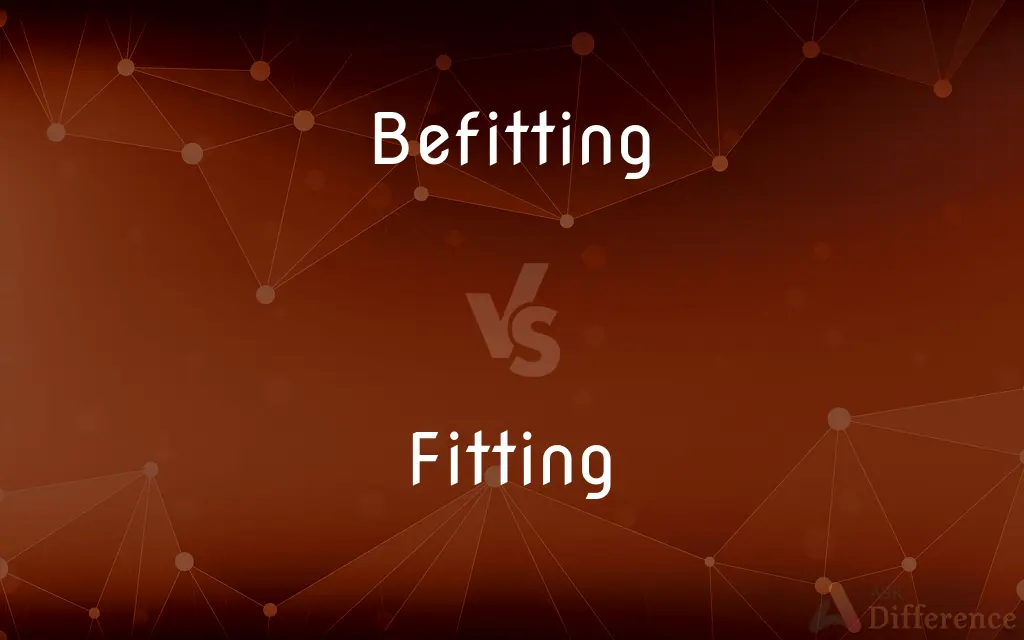Befitting vs. Fitting — What's the Difference?
By Tayyaba Rehman & Maham Liaqat — Updated on February 29, 2024
Befitting implies appropriateness with a touch of elegance or suitability for a specific role or occasion, while fitting refers to mere suitability or adequacy without implying any elegance.

Difference Between Befitting and Fitting
Table of Contents
ADVERTISEMENT
Key Differences
Befitting often carries a connotation of elegance or dignity, suggesting something is not only appropriate but also enhances the situation or person. It is used when something matches with a degree of respect or formality. Fitting, on the other hand, focuses on the aspect of being suitable or appropriate for a particular purpose or situation without necessarily adding a layer of elegance or formality. It's about matching or being adequate.
A befitting tribute would not only be appropriate but also honor the person in a dignified manner. A fitting response might be timely and appropriate, but not necessarily elevated in tone or style.
"Befitting" emphasizes a harmonious and often elevated match between an item and its context, "fitting" simply notes that something is right or appropriate. The difference lies in the level of suitability and the implied respect or enhancement.
The choice between befitting and fitting often depends on the desired implication of formality or elegance. Using "befitting" can elevate the subject, making it seem more prestigious or suitable in a distinguished way, whereas "fitting" is more neutral and broadly applicable.
"Befitting" is less common and more specific in its application, often reserved for formal or significant occasions. "Fitting," being more general, is widely used in everyday language to denote appropriateness without the connotation of elegance.
ADVERTISEMENT
Comparison Chart
Connotation
Implies elegance and suitability
Implies suitability or adequacy
Usage Context
Formal or dignified scenarios
General situations
Level of Suitability
Often suggests a higher level of appropriateness
Broadly denotes appropriateness
Formality
Tends to be more formal
Neutral, can be used in both formal and informal contexts
Frequency of Use
Less common, used in more specific contexts
More commonly used in a variety of contexts
Compare with Definitions
Befitting
Matching with elegance.
The gala's decor was befitting of its prestigious attendees.
Fitting
Corresponding in a suitable manner.
The book’s title is fitting given its content.
Befitting
Proper for the situation.
His speech was befitting the gravity of the event.
Fitting
Right for the situation.
A moment of silence was a fitting tribute to the victims.
Befitting
Reflecting well on someone.
His humble acceptance of the award was befitting his character.
Fitting
Properly aligned or adjusted.
The tailor ensured the suit was fitting perfectly.
Befitting
Appropriate and dignified.
A befitting ceremony was held in honor of the retiring principal.
Fitting
Being in keeping with a situation; appropriate.
Befitting
Suitable in a refined way.
She wore a dress befitting the solemnity of the occasion.
Fitting
The act of trying on clothes whose fit is being adjusted.
Befitting
Appropriate; suitable; proper.
Fitting
A small detachable part for a machine or apparatus.
Befitting
Present participle of befit
Fitting
Anything used in fitting up
Befitting
Appropriate, becoming
He moved with a befitting grace.
Fitting
Making or becoming suitable; adjusting to circumstances
Befitting
Suitable; proper; becoming; fitting.
Fitting
Being precisely fitting and right;
It is only meet that she should be seated first
Befitting
Appropriate to;
Behavior befitting a father
Fitting
Suitable or appropriate.
He received a fitting punishment for his actions.
Fitting
Adequately matching.
The ending was fitting for such a dramatic movie.
Common Curiosities
Can "fitting" and "befitting" be used interchangeably?
While they can be similar in context, befitting often adds an element of dignity that fitting does not.
What does befitting mean?
Befitting refers to something that is appropriately dignified or elegant for the situation.
Can an outfit be described as befitting?
Yes, if it notably complements the occasion with dignity or elegance.
Is befitting used in casual contexts?
Typically, befitting is reserved for more formal or significant occasions.
What is an example of a fitting response?
A straightforward apology for a minor mistake can be considered a fitting response.
What kind of events require a befitting tribute?
Events of significant emotional or formal importance often require a befitting tribute.
Can landscapes or settings be described as befitting?
Yes, when they particularly complement an event or narrative in an elegant manner.
How does fitting differ from befitting in usage?
Fitting is more about general suitability, while befitting implies a level of formality or elegance.
What makes something befitting?
Something is befitting if it is particularly suitable in a refined or dignified way.
Does fitting imply adequacy or perfection?
Fitting implies adequacy and appropriateness rather than perfection.
How does the frequency of use differ between the two?
Fitting is more commonly used in everyday language, while befitting is used less frequently and in more specific contexts.
Can a gesture be befitting?
Yes, if it elegantly matches the occasion or person’s status.
Is there a difference in formality between the two terms?
Yes, befitting is generally more formal than fitting.
Is it important to choose between befitting and fitting carefully?
Yes, the choice can affect the perceived formality or elegance of the statement.
Why might someone prefer to use "befitting" over "fitting"?
To emphasize the dignity, elegance, or formality of the suitability.
Share Your Discovery

Previous Comparison
Boycott vs. Embargo
Next Comparison
Road vs. TrackAuthor Spotlight
Written by
Tayyaba RehmanTayyaba Rehman is a distinguished writer, currently serving as a primary contributor to askdifference.com. As a researcher in semantics and etymology, Tayyaba's passion for the complexity of languages and their distinctions has found a perfect home on the platform. Tayyaba delves into the intricacies of language, distinguishing between commonly confused words and phrases, thereby providing clarity for readers worldwide.
Co-written by
Maham Liaqat













































